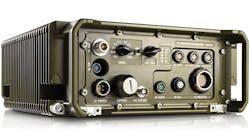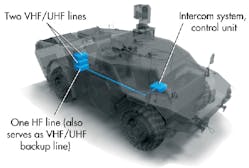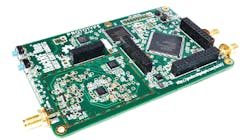This file type includes high resolution graphics and schematics when applicable.
In today’s rapidly evolving and dynamic wireless world, hardware that can adapt to a myriad of different environments is becoming more critical. From tactical communications to the common smartphone, highly configurable hardware can remove the design/development and end-user costs associated with having to upgrade system hardware for a simple feature change. Instead, a software upgrade can be instantly transmitted through the existing wireless infrastructure as soon as an upgrade becomes available.
By developing their own software, users also can implement a host of desired features without significant knowledge of the underlying hardware. Such scenarios—which would have been a dream only a few years ago—are now very much a reality, thanks to software-defined radios (SDRs) and Universal Software Radio Peripherals (USRPs; Fig. 1).
To create a layer of digital abstraction, SDRs leverage the power of modern general-purpose processors (GPPs) and clever reprogrammable-logic systems, such as field-programmable gate arrays (FPGAs). De-embedding the hardware from the digital plane eliminates the need to physically adjust RF/microwave components to enable behavioral feature changes, such as implementing the latest LTE standards. When an SDR operates as a USRP with virtual hardware instrumentation, it can extract and analyze information within complex RF signals.
Highly accurate analog-to-digital converters (ADCs), which are placed on either generic or application-specific peripherals, map RF signals that are moved to a lower frequency. The ADCs can digitize those signals using downconversion. These signals are then converted into digital recreations of the waveforms. Processing is done using digital-signal-processing (DSP) techniques that are often implemented with the DSP cores of aFPGA.
Clearly, such flexible radio architectures could enable the same hardware to be used to implement a wide range of telecommunications applications. This task could be done on the fly, without the designer needing significant RF/microwave knowledge, and potentially using community-generated code. As a result, this approach easily translates into dramatically lower development and upgrade costs.
Beyond telecommunications, SDR features also offer a host of advantages. Among other benefits, for example, tactical radios could adjust their communication algorithms based upon field conditions. Test and measurement instruments can receive cost-effective, software-licensed upgrades, which allows them to advance with the latest techniques. For their part, consumer products gain the ability to adapt to various wireless network situations for an optimum user experience. The applications that can benefit from SDR approaches are essentially infinite, given the ability to more easily generate the software backbone.
James Kimery, director of marketing for National Instruments, states, “Today, what’s driving a lot of momentum with SDR technology is that the software elements are available. Software is more plentiful and there is a community where code is shared, which helps with rapid adoption.” Yet the hardware to implement advanced SDR technology is still relatively expensive for certain applications. As a result, SDRs are more often used in applications in which the cost of the initial unit is offset by inexpensive upgradability and versatility. A few examples include tactical/public-safety radios, cellular base stations, test and measurement testbeds for interference/network mimicry, and rapid prototyping.
As the range of SDR applications is vast, so is the rest of the SDR landscape—especially considering form factors, capabilities, software tools, and companies offering SDR solutions. Companies like Rohde & Schwarz offer highly rugged and flexible SDRs for mission-critical systems (Figs. 2 and 3). For low-cost rapid-prototyping structures, firms like Analog Devices and Peregrine make whole RF-transceiver systems-on-a-chip (SoCs) that lend themselves to SDR implementation.
This file type includes high resolution graphics and schematics when applicable.
Going Smaller-Scale
This file type includes high resolution graphics and schematics when applicable.
Even small hobbyist companies, such as Great Scott Gadgets and Ettus Research, are rolling out affordable SDR prototyping units that previously would have been too expensive for the hobbyist consumer (Fig. 4). Meanwhile, companies like National Instruments and Nutaq are producing high-performance SDR modules and test/measurement equipment.
Driving this boom of SDR hardware and software development is the increased accessibility to integrated, low-power, and high-performance RF transceivers. Kimery says, “RF integrated circuits (ICs) are continually being offered in wider frequency ranges with smaller form factors. They consume less power and have a rich set of abilities. The performance of FPGAs also can’t be underestimated— they give you real-time software-processing-engineering capabilities.”
Such DSP density enables the rapid calculation of complex mathematics. Given the innate property of FPGA DSP systems for parallelization, they also enable SDR configurations that use multiple FPGAs in tandem. Other technologies, such as GPU and multicore CPU combinations, may lend themselves to SDR processing in the future. As FPGA SDR development is currently more streamlined for high-bandwidth operation, FPGAs may dominate the SDR markets for the time being. However, future research and developments could adapt GPU technology to take advantage of its massive parallel-processing capabilities.
To keep pace with the industry’s needs, FPGA vendors are offering more features that suit telecommunications applications. An example is the increased number of DSP cores in modern FPGAs. This approach has allowed NI’s USRP Rio to fit 1000 DSP cores in a single device. Kimery comments, “In the short term, we will see the continued adoption of FPGAs for SDR, as it is a strong trend. We have seen this trend in our business.”
Of course, implementing DSP technologies using FPGAs invites a challenge: Software must be developed that can use these devices’ extensive capabilities. Ultimately, software performance depends upon the environment in which the software is designed. Of course, its success also depends on the length of time that it takes for the software to be developed. To increase the ease and speed of software development for SDR applications, organizations like GNU Radio, Mathworks, and NI have developed graphically based programming languages. This style of programming could lead to a more intuitive programming design, which enables a software system to more closely resemble the hardware that it controls.
Some examples of these environments include GNURadio, Matlab/Simulink, and Labview. With a well-developed hardware and software partnership, SDR technology could be adapted to almost any telecommunications application—from providing wireless interconnects within automobiles to enabling highly adaptable millimeter-wave systems.
Given the increased interest in smart automobile systems, for instance, the Institute for Electrical and Electronics Engineers (IEEE) has developed standards for wireless access in vehicular environments (WAVE or IEEE 802.11p). One aim of automobile manufacturers has been to eliminate the wired connectivity between the many sensors and subsystems within a vehicle. Doing so has the ability to reduce costs and service time while enabling new features and allowing user customization. SDR technology could benefit this market, as highly integrated SDR devices could be used and flexibly configured throughout the automobile environment.
An area that is drawing attention from the industry as well as research and development groups is millimeter-wave technology. Building traditional radio architectures that are suited for millimeter-wave applications is generally costly, highly specialized, and prone to error. A millimeter-wave structure’s behavior is highly influenced by its direct environment. As a result, it must change its behavior according to environmental stimulus to provide adequate performance.
Meanwhile, millimeter-wave technology is advancing very rapidly, as there is a lot of interest in using millimeter-wave technology for the next 3GPP installment of Fifth-Generation (5G) telecommunications. Yet these rapid developments and unsolidified standards make investing in current hardware for millimeter-wave applications a potential risk. A highly adaptable SDR with built-in flexibility to environmental changes may allow for higher-performing millimeter-wave technologies. In addition, the use of USRP components may reduce the hardware configuration risks. Kimery states, “I see SDR being used heavily in millimeter-wave applications, as SDRs and phased-array antennas could make millimeter-wave systems commercially viable.”
Recent advances in SDR technology include hardware offerings like GPPs integrated with an FPGA in a single device, a “cell-phone”-grade complete RF front-end module, and advances in software support for SDRs. The Xilinx Zynq-7000 series of programmable SoCs, for example, includes the ARM Core Cortex processors, a wealth of I/O, on-chip memory, and a programmable logic center. In theory, strapping a Zynq device to an integrated RF front-end module would create a standalone and capable SDR with minimal hardware development and an already rich software environment.
Meanwhile, Peregrine’s Global 1 RF front end is reported to achieve gallium-arsenide (GaAs) -level performance using silicon-on-insulator (SoI) CMOS technology. In doing so, it could potentially replace the RF front end of a cell-phone with LTE capability.
In summary, more capable DSP cores are being included with advanced programmable-logic devices. This trend elevates the importance of the software that can harness these powerful devices. At the same time, the latest RF system-integration approaches are preparing to enable radio platforms with virtually infinitely configurable hardware and a rapidly reprogrammable structure. These advances could even allow for previously untapped markets for SDRs—namely, wireless Internet and cellular—to see a revolution in flexibility. Considering the push for 5G technologies and the proliferation of the Internet of Things (IoT), SDR technology may pave the way to massive-element wireless systems.
This file type includes high resolution graphics and schematics when applicable.





